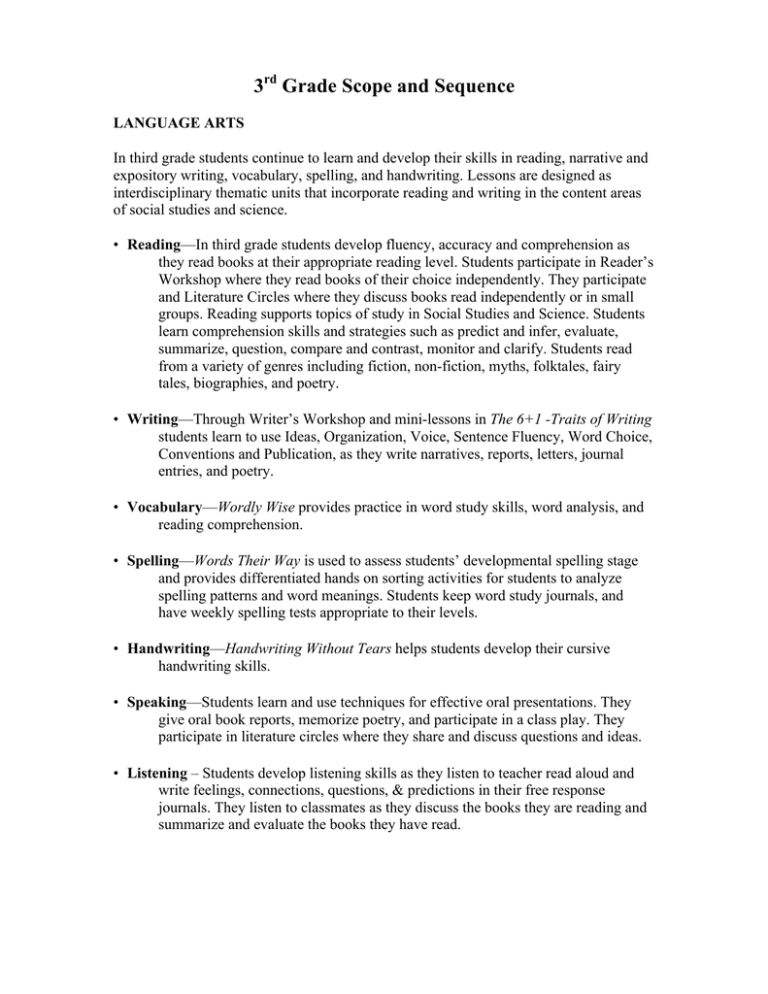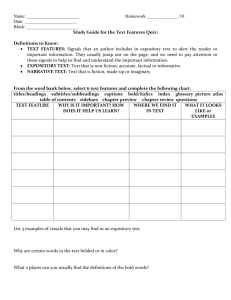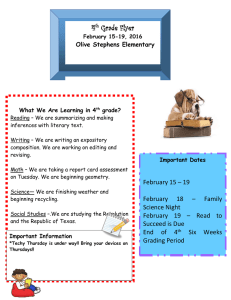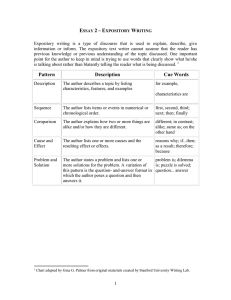3rd Grade Scope and Sequence
advertisement

3rd Grade Scope and Sequence LANGUAGE ARTS In third grade students continue to learn and develop their skills in reading, narrative and expository writing, vocabulary, spelling, and handwriting. Lessons are designed as interdisciplinary thematic units that incorporate reading and writing in the content areas of social studies and science. • Reading—In third grade students develop fluency, accuracy and comprehension as they read books at their appropriate reading level. Students participate in Reader’s Workshop where they read books of their choice independently. They participate and Literature Circles where they discuss books read independently or in small groups. Reading supports topics of study in Social Studies and Science. Students learn comprehension skills and strategies such as predict and infer, evaluate, summarize, question, compare and contrast, monitor and clarify. Students read from a variety of genres including fiction, non-fiction, myths, folktales, fairy tales, biographies, and poetry. • Writing—Through Writer’s Workshop and mini-lessons in The 6+1 -Traits of Writing students learn to use Ideas, Organization, Voice, Sentence Fluency, Word Choice, Conventions and Publication, as they write narratives, reports, letters, journal entries, and poetry. • Vocabulary—Wordly Wise provides practice in word study skills, word analysis, and reading comprehension. • Spelling—Words Their Way is used to assess students’ developmental spelling stage and provides differentiated hands on sorting activities for students to analyze spelling patterns and word meanings. Students keep word study journals, and have weekly spelling tests appropriate to their levels. • Handwriting—Handwriting Without Tears helps students develop their cursive handwriting skills. • Speaking—Students learn and use techniques for effective oral presentations. They give oral book reports, memorize poetry, and participate in a class play. They participate in literature circles where they share and discuss questions and ideas. • Listening – Students develop listening skills as they listen to teacher read aloud and write feelings, connections, questions, & predictions in their free response journals. They listen to classmates as they discuss the books they are reading and summarize and evaluate the books they have read. LANGUAGE ARTS September/October- Biomes Introduction to Reader’s & Writer’s Workshop; How to participate in a Literature Circle Students read: Fiction books about Biomes such as One Day in the Alpine Tundra, One Day in the Prairie, One Day in the Desert, One Day in the Woods, and One day in the Rainforest by Jean Craighead George and Magic Tree House Series books Dolphins at Daybreak, Afternoon in the Amazon, Good Morning Gorillas, and Polar Bears Past Bedtime by Mary Pope Osborne; they read Non-Fiction Books about Biomes such as the Magic Tree House Research Guides: Polar Bears and Rainforest; students read independent books of their choice. Teacher read aloud: Roald Dahl Expository Writing: Biomes Reports Narrative Writing: Stories with biome as setting Expository Writing: Biome Reports - How to write a T-Chart Outline, take notes, write a rough draft, edit, publish November/December/ January - – Chumash Students read: Non-Fiction – The Chumash Fiction - Badger Claws of Ojai, The Adventures of Little Bird, Annie & The Old One Teacher read alouds: Back in the Before Time & other myths Expository Writing: Chumash Reports Narrative Writing: Myths February/March – Astronomy Students read: Expository text – Space Magic Tree House Research Guide; Sun, Moon & Stars, Magic School Bus in Outer Space Fiction: Midnight on the Moon by Mary Pope Olsen Expository Writing: Planet Reports Narrative Writing: Stories with outer space as setting April/May – Biographies Students read and write Biographies of famous people such as Louis Braille, Benjamin Franklin, Helen Keller, Mother Teresa, Rosa Parks, Frederick Douglas, George Washington Carver, and Annie Oakley Expository Writing: Biographies June – Review, Assessment, Self Evaluations MATH In third grade students practice multiplication facts on a daily basis using Rocket Math, a program designed to allow students to move at their own pace. Students have daily lessons from the Excel curriculum, which spirals through third grade math standards. In this program concepts are introduced and then frequently review and practiced to achieve mastery. Students move from concrete to abstract understanding of math concepts through use of hands on manipulatives like place-value blocks, tile arrays, and fraction cubes. Students play math games and create their own word problems. Lesson Concepts taught throughout the year: Place Value & Counting Addition of Whole Numbers Subtraction of Whole Numbers Multiplication of Whole Numbers Division of Whole Numbers Fractions Money Time: Clock & Calendar Odd & Even Numbers Word Problems Measurement Geometry Pre-Algebra Probability Graphs SCIENCE In third grade science is primarily taught using the Foss Science curriculum that has three units: Sun, Moon & Stars, Matter & Energy, and Structures of Life. Students learn to make scientific observations and keep science journals. Students read Magic School Bus and Magic Tree House as well as other literature to support science units we are studying. Students take a field trip to the Planetarium at the Santa Barbara Museum of Natural History. Students observe and study their local natural environment and take weekly nature walks in the Oak Grove, Saddle Mountain, and Besant Meadow. Students develop an appreciation for nature and learn to identify local insects, birds, trees, plants, and mammals. September/October – Biomes/ Structures of Life February/March – Sun, Moon, & Stars April/ May/June – Matter & Energy/Mini Solar Cars Project SOCIAL STUDIES In third grade the focus is on learning about the local community. Students study local geography, local Native American populations, local immigrant groups, local history, and local economy. They read and write about each topic of study. Students take a variety of field trips to local landforms, Santa Barbara Museum of Natural History, The Ojai Museum, local farms and business. Guest speakers such as Julie Tumamait, a Chumash Elder, come to visit the class. Students interview people about why their families came to live in Ojai. September/October – Local Geography November/ December – Chumash Project March/ April – Local History, Government & Economy


